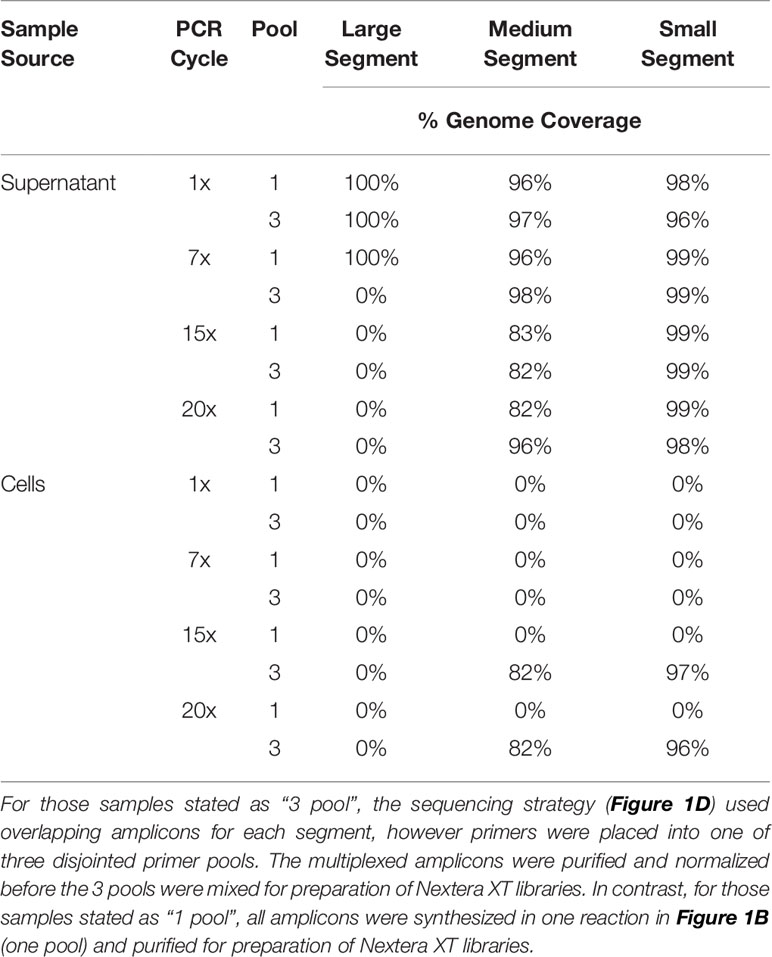- 1Department of Microbiology, Immunology and Biochemistry, The University of Tennessee Health Science Center, Memphis, TN, United States
- 2Department of Biomedical Informatics, College of Medicine, University of Arkansas for Medical Sciences, Little Rock, AR, United States
A Corrigendum on
Amplicon-Based, Next-Generation Sequencing Approaches to Characterize Single Nucleotide Polymorphisms of Orthohantavirus Species
By Taylor MK, Williams EP, Wongsurawat T, Jenjaroenpun P, Nookaew I and Jonsson CB (2020). Front. Cell. Infect. Microbiol. 10:565591. doi: 10.3389/fcimb.2020.565591
Error in Figure/Table
In the original article, there was a mistake in Table 3 as published. The data under columns for the header “Large segment” and the header “Small segment” were mistakenly switched prior to submission. The corrected Table 3 appears below.
The authors apologize for this error and state that this does not change the scientific conclusions of the article in any way. The original article has been updated.
In the original article, there was an error. This error included a statement which described the incorrect Table 3 in the Results section.
A correction has been made to Results, Two-Step Amplification of Full-Length Sequences of S, M, and L Segment vRNA of ANDV Using MiSeq From ANDV-Infected Vero E6 Supernatant or ANDV-Infected Vero E6 Cells, Paragraph number 5:
We used a 400x depth of coverage threshold to assess ANDV genome coverage (Table 3). The supernatant samples which gave the highest genome coverage across all segments was the 1x PCR and 7x PCR. The samples from infected cells showed good coverage at 15x and 20x PCR cycles although this was only true for the S and M segments as the L segment provided no coverage at this depth.
The authors apologize for this error and state that this does not change the scientific conclusions of the article in any way. The original article has been updated.
Publisher’s Note
All claims expressed in this article are solely those of the authors and do not necessarily represent those of their affiliated organizations, or those of the publisher, the editors and the reviewers. Any product that may be evaluated in this article, or claim that may be made by its manufacturer, is not guaranteed or endorsed by the publisher.
Keywords: hantavirus, Orthohantavirus, NGS, next generation sequencing, MinION, illumina MiSeq, single nucleotide polymorphism, SNP
Citation: Taylor MK, Williams EP, Wongsurawat T, Jenjaroenpun P, Nookaew I and Jonsson CB (2022) Corrigendum: Amplicon-Based, Next-Generation Sequencing Approaches to Characterize Single Nucleotide Polymorphisms of Orthohantavirus Species. Front. Cell. Infect. Microbiol. 11:804914. doi: 10.3389/fcimb.2021.804914
Received: 29 October 2021; Accepted: 15 November 2021;
Published: 24 January 2022.
Edited and reviewed by:
Connie S. Schmaljohn, Integrated Research Facility (NIAID), United StatesCopyright © 2022 Taylor, Williams, Wongsurawat, Jenjaroenpun, Nookaew and Jonsson. This is an open-access article distributed under the terms of the Creative Commons Attribution License (CC BY). The use, distribution or reproduction in other forums is permitted, provided the original author(s) and the copyright owner(s) are credited and that the original publication in this journal is cited, in accordance with accepted academic practice. No use, distribution or reproduction is permitted which does not comply with these terms.
*Correspondence: Colleen B. Jonsson, Y2pvbnNzb25AdXRoc2MuZWR1
 Mariah K. Taylor
Mariah K. Taylor Evan P. Williams
Evan P. Williams Thidathip Wongsurawat
Thidathip Wongsurawat Piroon Jenjaroenpun
Piroon Jenjaroenpun Intawat Nookaew
Intawat Nookaew Colleen B. Jonsson
Colleen B. Jonsson